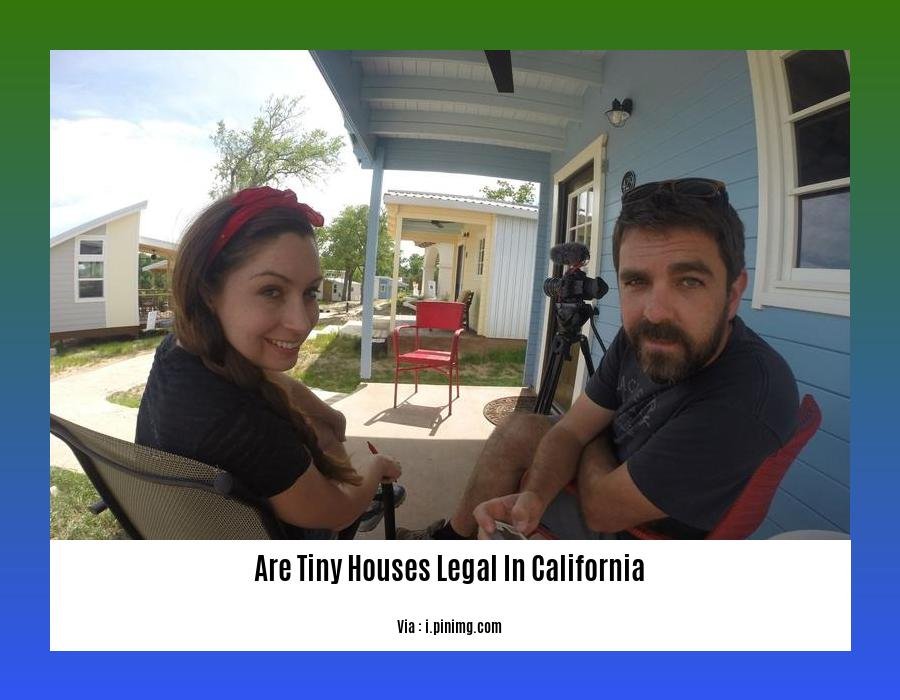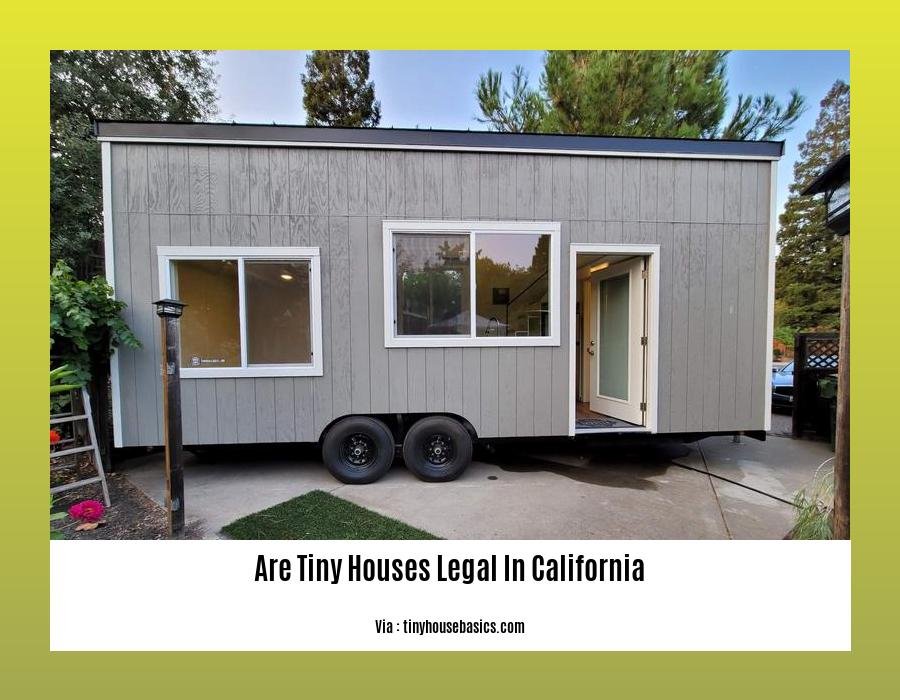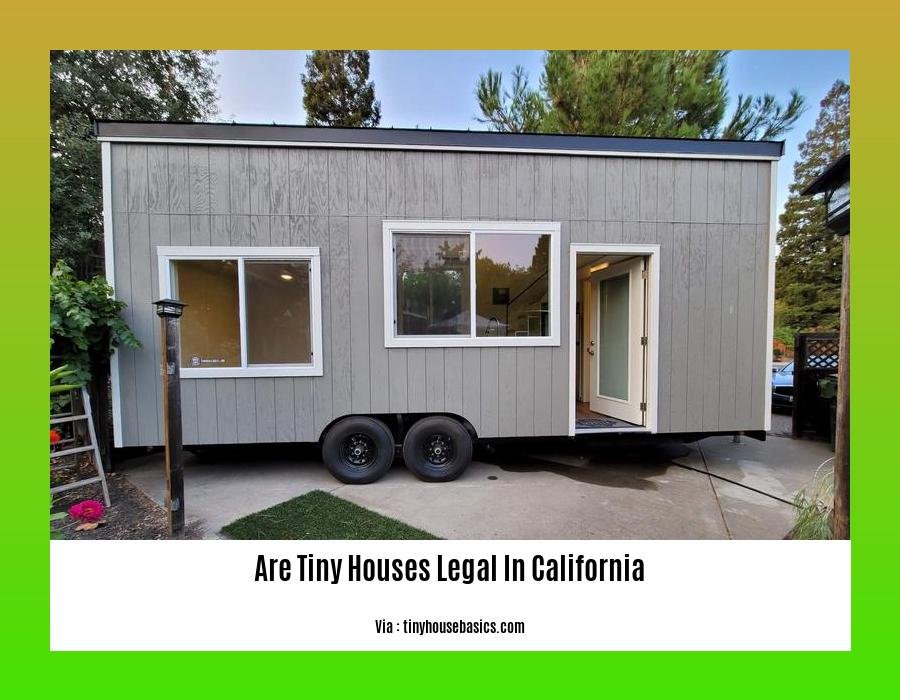Are Tiny Houses Legal in California? An In-Depth Look at Regulations, Challenges, and Opportunities
Key Takeaways:
-
Tiny homes are authorized in California, but specific guidelines must be met.
-
There are two primary methods to reside legally in a tiny home in California:
-
Securing a special use permit.
-
Connecting to an RV park.
-
Tiny homes offered for sale, rent, lease, or occupancy in California must adhere to safety regulations and other criteria.
Are Tiny Houses Legal in California?

Absolutely! California embraces the concept of tiny house living, recognizing its potential for sustainable and affordable housing. While tiny houses are legal in California, adhering to specific regulations is crucial.
How to Legally Live in a Tiny House in California
-
Obtain a Special Use Permit:
-
Contact your local government to inquire about obtaining a special use permit.
- Clearly outline your plans, including the tiny house’s location and compliance with local zoning laws.
-
Be prepared to address any concerns or objections from neighbors or community members.
-
Connect to an RV Park:
-
Partner with an RV park that allows long-term tiny house residency.
- Ensure the RV park meets California’s health and safety standards for tiny homes.
- Research and compare different RV parks to find one that suits your needs and budget.
Regulations for Tiny Homes in California
Tiny homes in California must meet specific safety and construction standards:
- Building Codes: Adhere to the California Building Code and any local building codes that apply to tiny houses.
- Size Restrictions: Maximum size limits may vary depending on local regulations; typically, tiny homes range from 100 to 400 square feet.
- Foundation Requirements: Tiny houses must have a permanent foundation, such as a concrete pad or piers.
- Plumbing and Electrical Systems: Ensure proper installation and compliance with California’s plumbing and electrical codes.
- Safety Features: Install smoke and carbon monoxide detectors, fire extinguishers, and other safety devices as required by law.
Challenges and Opportunities
While tiny house living offers unique opportunities, it also presents challenges:
- Financing: Securing traditional financing for a tiny house can be challenging due to its unique nature. Explore alternative financing options, such as personal loans or crowdfunding.
- Zoning Restrictions: Zoning laws can limit where you can legally place your tiny home; research local zoning regulations to find suitable locations.
- Community Acceptance: Tiny houses may face resistance from some communities due to misconceptions or concerns about their impact on neighborhoods. Engage with your community and address any concerns proactively.
Despite these challenges, tiny houses offer many opportunities:
- Affordability: Tiny houses are generally more affordable than traditional homes, making homeownership accessible to a broader population.
- Sustainability: Tiny houses promote sustainable living by reducing energy consumption and minimizing environmental impact.
- Mobility: Tiny houses offer the freedom to move easily, allowing you to explore different locations and lifestyles.
Conclusion
Are tiny houses legal in California? Yes, but regulations must be followed. With careful planning and adherence to local laws, you can enjoy the benefits of tiny house living in the Golden State.
If you have been looking for a home away from home or a private space for family, discover our elegant and spacious 4-bedroom bungalow designs in Nigeria.
Explore our collection of 4-bedroom maisonette designs in Kenya that exhibit a contemporary mix of modern and traditional architectural styles.
Thinking of joining the tiny home movement? Check out our in-depth analysis on whether tiny homes are legal in California and learn the zoning regulations and building codes you need to know before building your dream tiny home.
Building Codes and Tiny Houses
Navigating Building Codes: A Tiny House Journey in California
In the Golden State, tiny homes aren’t a whimsical novelty but a legitimate housing option. However, like any dwelling, they must comply with specific building codes to ensure safety and quality. Let’s demystify the building code landscape for tiny houses in California.
Understanding the Framework: California Building Standards Code (CBSC)
At the heart of building regulations in California lies the CBSC, a comprehensive guide to ensure safety and habitability in all types of structures, including tiny houses. This codebook outlines the minimum requirements for construction, design, and materials.
Space and Dimension Stipulations
-
Ceiling Height: Your tiny home’s ceiling must be at least 7 feet 6 inches high, providing ample headroom for comfortable living.
-
Floor Area: To ensure adequate living space, at least one room in your tiny home should have a gross floor area of 120 square feet or more. The remaining living spaces must boast a net floor area of at least 70 square feet.
Key Takeaways:
- California’s CBSC governs building codes for tiny houses, ensuring safety and quality.
- Tiny houses must meet specific space requirements, including a minimum ceiling height of 7 feet 6 inches and a minimum gross floor area of 120 square feet in one room.
- Plumbing, electrical systems, and safety features must adhere to CBSC standards.
- Local zoning laws may impose additional regulations on tiny house placement and use.
Sources:
- California’s Tiny Home Rules and Regulations
- California Tiny House Laws You Must Know
Challenges and Opportunities for Tiny Homes

Tiny houses continue to be popular among Californians searching for flexible, ecological dwellings. The allure of tiny living stems from its affordability, sustainability, and mobility advantages. However, certain challenges and opportunities must be considered when embarking on this journey.
Challenges:
-
Financing and Lending Restrictions: Securing traditional financing for tiny homes can be a challenge, as lenders may be hesitant due to perceived risks. Creative financing options, such as personal loans or crowdfunding, may be necessary.
-
Zoning Regulations: Zoning laws in many California cities and counties may restrict the placement of tiny homes, especially in traditional residential neighborhoods. Researching local zoning regulations is essential before deciding on a tiny home location.
-
Community Acceptance: Tiny homes often face opposition from neighbors who may have concerns about aesthetics, property values, or increased traffic. Building relationships with neighbors and addressing their concerns can help foster acceptance.
Opportunities:
-
Affordability: Tiny homes offer a more affordable housing option compared to traditional homes, making them an attractive option for those seeking financial freedom.
-
Sustainability: Tiny homes promote sustainability by reducing energy consumption, utilizing eco-friendly materials, and minimizing waste. They align well with California’s goals for environmental conservation.
-
Mobility: Tiny homes provide the freedom to move easily, whether for job relocations, travel, or simply a change of scenery. This mobility can be particularly appealing to those seeking an adventurous lifestyle.
Key Takeaways:
- While tiny homes are legal in California, regulations must be met, such as obtaining special use permits or connecting to approved RV parks.
- Financing tiny homes can be challenging, with creative options like personal loans or crowdfunding being necessary.
- Zoning restrictions may limit tiny house placement, requiring research into local regulations.
- Community acceptance can be an issue, with addressing neighbors’ concerns being crucial.
- Tiny homes offer affordability, sustainability, and mobility advantages.
- California embraces tiny living as a viable and sustainable housing alternative.
Sources
[1] California’s Tiny Home Rules and Regulations: [
[2] California Tiny House Laws You Must Know: [
Legal Status of Tiny Homes in California
In the enchanting land of California, where dreams of sustainable living harmonize with a yearning for wide-open spaces, the legal status of tiny homes has garnered significant attention. These compact abodes, often nestled on wheels or sturdy foundations, offer a unique blend of affordability, mobility, and eco-consciousness.
Key Takeaways:
– California embraces the concept of tiny house living, allowing individuals to build and reside in these compact dwellings.
– Regulations vary depending on the specific location and zoning ordinances.
– Two primary methods exist for legally living in a tiny home: obtaining a special use permit or connecting to an RV park.
– Tiny houses must comply with building codes, size restrictions, and safety features.
– Challenges include financing, zoning restrictions, and community acceptance, while opportunities include affordability, sustainability, and the joy of living in a cozy, self-sufficient space.
In this article, we’ll delve into the intricacies of tiny home regulations in California, shedding light on the challenges faced and the opportunities embraced by those seeking this alternative lifestyle:
Regulations:
-
California’s stance on tiny homes is welcoming, with no statewide size restrictions that prohibit their construction and residency. However, local zoning ordinances may impose specific regulations, dictating where these compact homes can be placed.
-
To legally inhabit a tiny home in California, two primary avenues exist:
-
Obtaining a special use permit, which allows for the placement of a tiny home on private property, provided it meets certain requirements and zoning guidelines.
-
Connecting to an RV park that permits long-term residency, offering a sense of community and access to necessary amenities.
Challenges:
-
Financing a tiny home can be a formidable hurdle, as traditional mortgage options may not be readily available. Creative financing solutions, such as personal loans or crowdfunding, often come into play.
-
Zoning restrictions can pose a significant obstacle, as some communities may not explicitly allow tiny homes or have specific size or placement requirements that must be met.
-
Gaining community acceptance can be an ongoing challenge, as tiny homes may be perceived as unconventional or disruptive to the established neighborhood aesthetic.
Opportunities:
-
Affordability remains a key advantage of tiny homes, offering a cost-effective housing alternative compared to traditional dwellings.
-
Sustainability is at the core of the tiny house movement, promoting a reduced environmental footprint through energy efficiency and a smaller carbon footprint.
-
Mobility is a defining characteristic of tiny homes, allowing for the freedom to relocate and embrace a nomadic lifestyle.
As the tiny house movement continues to gain momentum in California, it’s crucial to stay informed about the legal landscape and the opportunities and challenges that come with this unique lifestyle.
*Citations:
FAQ
Q1: Are tiny houses legal in California?
A1: Yes, tiny houses are legal in California, but specific regulations must be followed to live in a tiny house legally.
Q2: What are the two main ways to live legally in a tiny home in California?
A2: The two main ways to live legally in a tiny home in California are by obtaining a special use permit or by connecting your tiny home to an RV park.
Q3: What safety standards and requirements must tiny homes sold, rented, or leased in California meet?
A3: Tiny homes sold, rented, or leased in California must meet specific safety standards and requirements, including compliance with the California Building Standards Code (CBSC) and minimum ceiling height and floor area requirements.
Q4: Are there any size restrictions for tiny houses in California?
A4: No, there are no statewide size restrictions for tiny houses in California, allowing individuals to build and reside in tiny houses as they see fit. However, specific local zoning ordinances may limit where tiny houses can be placed.
Q5: What are some of the challenges faced by those interested in living in tiny homes in California?
A5: Some of the challenges faced by those interested in living in tiny homes in California include obtaining the necessary permits and approvals, finding suitable parking locations, and dealing with zoning restrictions and regulations that may limit where tiny houses can be placed.
- How to Get Rid of Mushrooms in Your Lawn: A Complete Guide - April 24, 2025
- How to Get Rid of Ground Hornets: A Safe and Effective Guide to Eliminating Nests - April 24, 2025
- How to Get Rid of German Roaches Fast: DIY Methods for Quick Control - April 24, 2025










